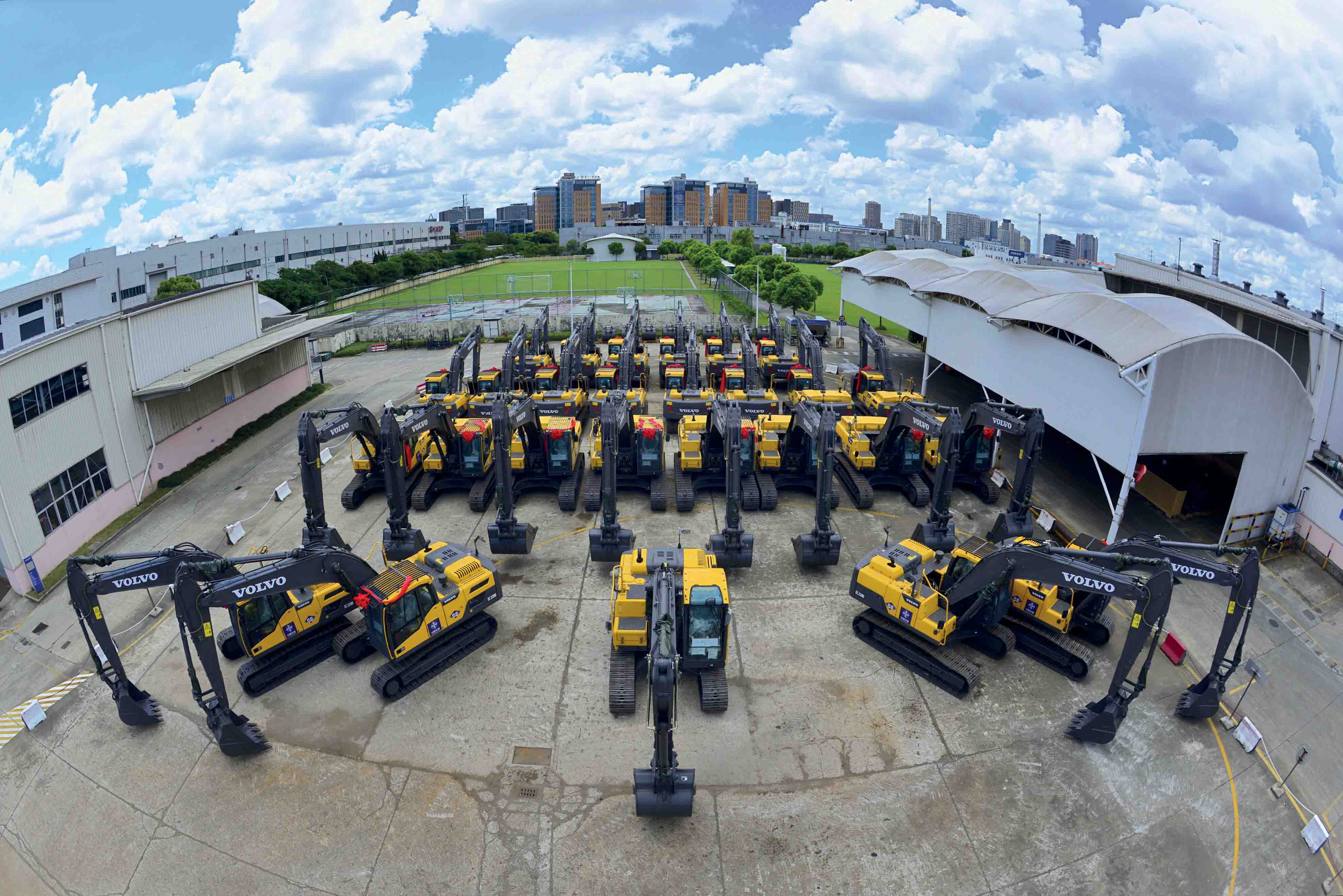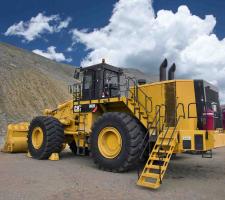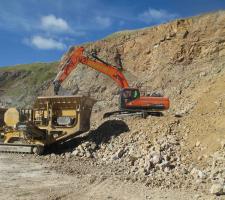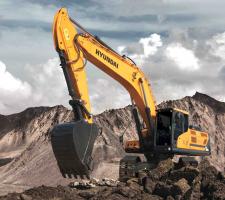
Equipment manufacturers unveil the latest machines for loading, including an autonomous machine, as Patrick Smith reports.
Volvo Construction Equipment has given a glimpse of what could be the future of hauling with its prototype autonomous wheeled loader and articulated hauler working together.
In a one-hour comparison, it was found that the autonomous wheeled loader could match up to 70% of a skilled oeprator’s productivity levels when loading and unloading.
The equipment was unveiled at the company’s Xploration Forum, held in Eskilstuna, Sweden, where it was revealed the loader has already done real work for a
“The demonstration machines were programmed to work together and carry out a specific set of actions on a pre-defined route,” says Jenny Elfsberg, director of emerging technologies at Volvo CE.
“The machines can perform the same task over and over again, along a fixed route, for a relatively long period of time. But it’s still early days for this technology. We are working on developing solutions that have the required safety and performance levels that the market will accept.
“There is still a long way to go so there are no plans for industrialisation at this stage.”
The demonstrator machines, a standard Volvo CE L120 wheeled loader and an A25F articulated hauler, have been upgraded with the autonomous technology.
The company also presented a prototype electric hybrid wheeled loader, LX1, which it says can deliver up to a 50% improvement in fuel efficiency along with a significant reduction in emissions and noise pollution.
The LX1 incorporates a driveline that consists of electric drive motors mounted at the wheels; electric hydraulics; an energy storage system; a significantly smaller diesel engine, and new machine architecture.
Volvo CE says the prototype, which has 98% new parts and a fundamentally new machine design, is capable of doing the work of a wheeled loader that is one size larger. At this stage, the LX1 is part of a research project and is not commercially available.
Meanwhile, China Road and Bridge is mobilising a fleet of 52 machines from Volvo CE, comprising EC220D and EC300DL crawler excavators, to work on a section of The One Belt, One Road initiative, which includes plans to revive trade routes along the ancient Silk Road, as well as connect China with the rest of Eurasia.
Part of the new economic corridor is a 102km section of the Karokoram Highway-II that links the cities of Thakot and Havelian in northern Pakistan, and here the excavators will be used for digging-up and spoil removal duties. With a breakout force of 205kN and tear-out force of 166kN, the 30tonne excavator is fitted with a Volvo D7 engine, delivering a maximum power of 169kW.
The 20tonne EC220D crawler excavators are said to be ideal for general earthmoving applications, and in addition to this, the fleet has also been supplied with Volvo hydraulic breakers, for rock-breaking on the project.
Volvo CE says that delivery of the machines to Pakistan, and on such a prestigious project, is an important step in its own Asian development.
Other new developments from the company include its 75tonne class EC750E crawler excavator, powered by Volvo’s Tier 4 Final/Stage IV compliant D16 engine, which delivers increased power of 374kW, and Volvo’s largest crawler excavator, the EC950E. Available in less regulated markets, the 90tonne machine is powered by a 446kW Volvo D16 engine.
Designed to lower fuel costs and increase operating efficiency, the recently-updated
“With the new on-demand throttle arrangement, the 992K automatically manages engine speed, combining the efficiency of a manual throttle with ergonomic throttle lock operation,” says Caterpillar.
“Performance studies have shown the 992K reduces fuel consumption by as much as 21% compared to the previous model series.
“Production-matched to deliver efficient three-pass loading of the Cat 775 and four-pass loading of the Cat 777 trucks, the 992K now offers Cat Production Measurement (CPM), the advanced payload weight measuring system. CPM promotes cost-effective hauling by helping loader operators minimise truck under-loading and overloading.”
Several new features of the updated 992K are said to enhance operating safety.
“The loader is built fire-suppression ready, which simplifies installation and provides system integration to enhance reliability. Fall protection tie-offs provide fall arrest for service technicians when working on the loader. The 992K design includes turn signals and hazard lights; a bi-directional emergency gate; wheel chocks, and mid-rails for enhanced safety when cleaning windows.”
The company says that a common mining cab design for Caterpillar’s four largest wheeled loaders and two largest wheeled dozers helps ensure parts availability and helps keep inventory costs down.
The 992K’s Vital Information Management System (VIMS) continually monitors machine health and provides operators, service personnel and fleet managers operating information across a wide range of critical loader functions. Offering a net 607kW rating, the Cat C32 ACERT engine powers the 992K. Depending on regional needs, it can be configured to meet US EPA Tier 4 Final/EU Stage IV or US EPA Tier 2/EU Stage IIa emissions regulations.
The loader’s 10.7-12.3m3 bucket capacities offer a standard lift payload of 21.7tonnes and 19.1tonne high lift payload.
Garriock Bros, one of the biggest privately-owned companies in the Shetland Islands in Scotland, has bought new
With depots in Lerwick and Brae, the company also operates ten different divisions through five branches in Shetland, Orkney, Edinburgh and Inverness in Scotland, and Coventry in the Midlands region of England, in markets including contract crushing and quarrying.
The Doosan excavators are part of the rental fleet managed by the Garriock Bros depot in the village of Muir of Ord, near Inverness, which opened in January 2015 and is managed by Brian Buchan.
“The Doosan DX340LC-5 excavator is on hire to
Providing significantly improved performance compared to the previous LC-3 Stage IIIB model, the operating weight of the 36tonnes DX340LC-5 excavator has increased by 1,300kg, resulting in increased lifting capacities of 1% and 5% over the front and side.
The DX340LC-5 is powered by the
“As well as the Scania engine, new innovative and exclusive features have been introduced that lead to significant reductions in fuel consumption amounting to an average of 6% compared to the Stage IIIB machine,” says Doosan.
With an operating weight of 23.9tonnes, the DX225SLR-3 is powered by the Doosan DL06K diesel engine providing 124kW of power at 1,800rpm.
With an operating weight of 38.92tonnes, the machine is one of 13 new Hyundai HX crawler excavators, and is powered by the low emission
“The HX380 L can offer a reduction in fuel consumption of up to 19%, depending on the type of operation, in comparison to Hyundai’s 9A-series of machines,” says the company.
“As with existing models in the HX series, the HX380 L features Hyundai’s new Variable Power Control, which allows operators to set their own preferences for boom or swing priority; power mode selection, including three working modes, P (Power), S (Standard), and E (Economy), and optional work tool settings at the touch of a button, to suit the task in hand.”

















